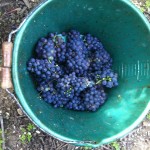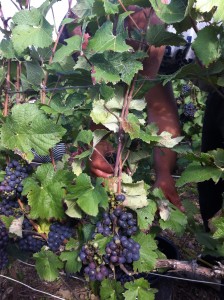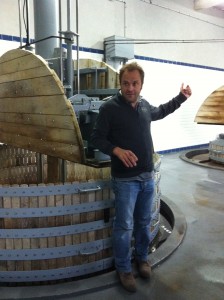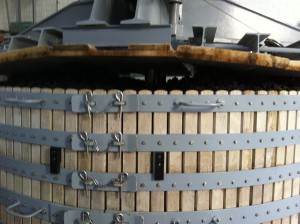2013 has not been the easiest year, in Champagne as in other regions. It seemed like winter went on forever, spring never really happened and flowering only occurred at the beginning of summer – about three weeks later than usual. Summer was great as it was sunny and very hot, and even though a few areas suffered hail damage, the heat dried up the broken berries and the other grapes compensated to make relatively big beautiful bunches. Things were looking up providing the weather held up in September. Unfortunately we had about two weeks of cold rainy weather, which slowed the ripening process and increased the risk of rot. This week the sun came out to play again and everybody is hoping she will hang around for a bit as in a lot of places the harvest will not start till October.
Harvest is very regulated in Champagne. The start dates are set village by village and variety by variety, and this year the dates are all over the place. The main reason for why there is a two week difference between the first and the last villages is because flowering happened the same way. Some areas flowered at the end of June whilst some places had to weight for the July sun for flowering to happen. The cold weather in June furthermore caused irregularities resulting in a lot of hen and chicken (milrendage) in these earlier bunches. Anyway, harvest kicked off yesterday in the Aube in Buxeuil and Balnot-sur-Laignes and today here in the Marne area in Cummière and Bethon.
The fact that Cummière, which is situated just under my village, can start 6 days earlier than Hautvillers shows off well – in my opinion – the difference in micro-climates we have in Champagne.
One of these details is working in a gravity fed way. Grapes are delivered at the top of the building and processed vineyard by vineyard. They are weight by the forklift and entered in a wee computer attached to the forklift. The crates are entered into the press house and poured into the traditional 4000 kg round Coquard press. Just under the press house is the winery and the juice runs from the press directly into the tanks. The first 60 liters is run off into the first tailles, and the first two pressings make up the cuvée. This means, that instead of the allowed 20 hectoliters of cuvée, Jean-Baptiste only keeps 18 hectoliters. The last two pressings are collected (and later vinified) as first and second tailles. Once the pressing has been completed, the juice is left in the different tanks overnight to settle and will be racked in the morning. After that the juice is pumped into 3 different tanks to start the first fermentation. Geoffroy likes to work with natural yeasts, but more than anything he likes to have clean and fresh wines. He admitted that for this first Marc he may choose to use oculated yeast if the fermentation does not start straight away. This harvest he will test different ways of limiting sulfites in the wine making process. Normally a little sulfite is added as the juice runs from the press in to the receiving tanks. This helps to stabilize the must and has as an added advantage that it takes away some colour. Jean Baptiste will test adding less sulfites the normal way, as well as adding the sulfites (in a smaller quantity) once once he has collected the 18 hectoliters of the cuvée in the tank. He is helped by the CIVC research center who will analyse the results.
Harvest will properly kick off at Champagne Geoffroy from tomorrow on when another 20 pickers arrive. In total the company employs 25 pickers and debardeurs (grape carriers) and 5 winery staff – of which 3 work at the press and 2 in the winery. Jean Baptiste thinks vintage will continue for another 2 weeks, which is pretty unusual for Champagne, but linked to the split flowering. Weather permitting he would like to avoid working on Sunday to try and stay under the newly imposed social security platforms which increase the charges from 8 to 44%. The change in the social security regulation is a seriously bitter pill to swallow for most Champenois winegrowers with more than five hectares.




